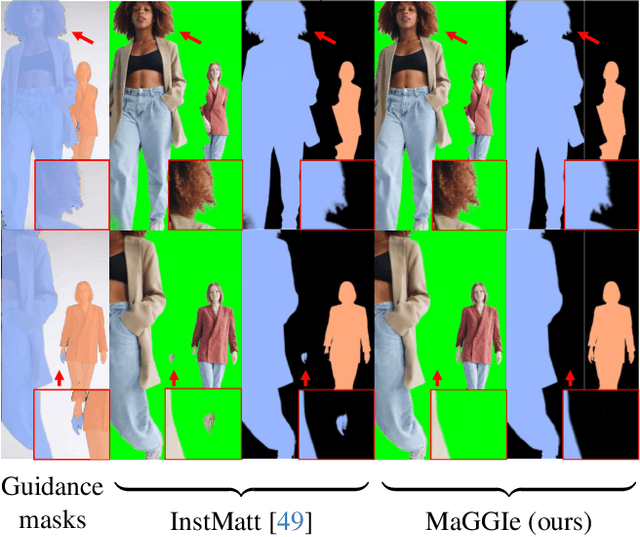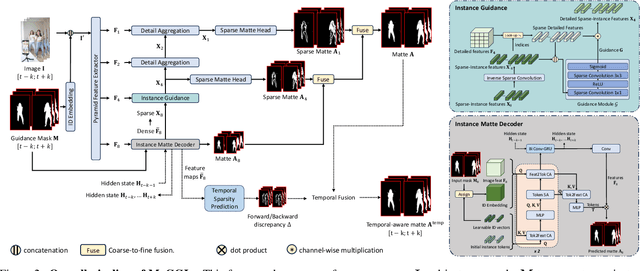Chuong Huynh
CoLLM: A Large Language Model for Composed Image Retrieval
Mar 25, 2025Abstract:Composed Image Retrieval (CIR) is a complex task that aims to retrieve images based on a multimodal query. Typical training data consists of triplets containing a reference image, a textual description of desired modifications, and the target image, which are expensive and time-consuming to acquire. The scarcity of CIR datasets has led to zero-shot approaches utilizing synthetic triplets or leveraging vision-language models (VLMs) with ubiquitous web-crawled image-caption pairs. However, these methods have significant limitations: synthetic triplets suffer from limited scale, lack of diversity, and unnatural modification text, while image-caption pairs hinder joint embedding learning of the multimodal query due to the absence of triplet data. Moreover, existing approaches struggle with complex and nuanced modification texts that demand sophisticated fusion and understanding of vision and language modalities. We present CoLLM, a one-stop framework that effectively addresses these limitations. Our approach generates triplets on-the-fly from image-caption pairs, enabling supervised training without manual annotation. We leverage Large Language Models (LLMs) to generate joint embeddings of reference images and modification texts, facilitating deeper multimodal fusion. Additionally, we introduce Multi-Text CIR (MTCIR), a large-scale dataset comprising 3.4M samples, and refine existing CIR benchmarks (CIRR and Fashion-IQ) to enhance evaluation reliability. Experimental results demonstrate that CoLLM achieves state-of-the-art performance across multiple CIR benchmarks and settings. MTCIR yields competitive results, with up to 15% performance improvement. Our refined benchmarks provide more reliable evaluation metrics for CIR models, contributing to the advancement of this important field.
VeriGraph: Scene Graphs for Execution Verifiable Robot Planning
Nov 15, 2024



Abstract:Recent advancements in vision-language models (VLMs) offer potential for robot task planning, but challenges remain due to VLMs' tendency to generate incorrect action sequences. To address these limitations, we propose VeriGraph, a novel framework that integrates VLMs for robotic planning while verifying action feasibility. VeriGraph employs scene graphs as an intermediate representation, capturing key objects and spatial relationships to improve plan verification and refinement. The system generates a scene graph from input images and uses it to iteratively check and correct action sequences generated by an LLM-based task planner, ensuring constraints are respected and actions are executable. Our approach significantly enhances task completion rates across diverse manipulation scenarios, outperforming baseline methods by 58% for language-based tasks and 30% for image-based tasks.
Composing Object Relations and Attributes for Image-Text Matching
Jun 17, 2024



Abstract:We study the visual semantic embedding problem for image-text matching. Most existing work utilizes a tailored cross-attention mechanism to perform local alignment across the two image and text modalities. This is computationally expensive, even though it is more powerful than the unimodal dual-encoder approach. This work introduces a dual-encoder image-text matching model, leveraging a scene graph to represent captions with nodes for objects and attributes interconnected by relational edges. Utilizing a graph attention network, our model efficiently encodes object-attribute and object-object semantic relations, resulting in a robust and fast-performing system. Representing caption as a scene graph offers the ability to utilize the strong relational inductive bias of graph neural networks to learn object-attribute and object-object relations effectively. To train the model, we propose losses that align the image and caption both at the holistic level (image-caption) and the local level (image-object entity), which we show is key to the success of the model. Our model is termed Composition model for Object Relations and Attributes, CORA. Experimental results on two prominent image-text retrieval benchmarks, Flickr30K and MSCOCO, demonstrate that CORA outperforms existing state-of-the-art computationally expensive cross-attention methods regarding recall score while achieving fast computation speed of the dual encoder.
MaGGIe: Masked Guided Gradual Human Instance Matting
Apr 24, 2024



Abstract:Human matting is a foundation task in image and video processing, where human foreground pixels are extracted from the input. Prior works either improve the accuracy by additional guidance or improve the temporal consistency of a single instance across frames. We propose a new framework MaGGIe, Masked Guided Gradual Human Instance Matting, which predicts alpha mattes progressively for each human instances while maintaining the computational cost, precision, and consistency. Our method leverages modern architectures, including transformer attention and sparse convolution, to output all instance mattes simultaneously without exploding memory and latency. Although keeping constant inference costs in the multiple-instance scenario, our framework achieves robust and versatile performance on our proposed synthesized benchmarks. With the higher quality image and video matting benchmarks, the novel multi-instance synthesis approach from publicly available sources is introduced to increase the generalization of models in real-world scenarios.
SimpSON: Simplifying Photo Cleanup with Single-Click Distracting Object Segmentation Network
May 28, 2023Abstract:In photo editing, it is common practice to remove visual distractions to improve the overall image quality and highlight the primary subject. However, manually selecting and removing these small and dense distracting regions can be a laborious and time-consuming task. In this paper, we propose an interactive distractor selection method that is optimized to achieve the task with just a single click. Our method surpasses the precision and recall achieved by the traditional method of running panoptic segmentation and then selecting the segments containing the clicks. We also showcase how a transformer-based module can be used to identify more distracting regions similar to the user's click position. Our experiments demonstrate that the model can effectively and accurately segment unknown distracting objects interactively and in groups. By significantly simplifying the photo cleaning and retouching process, our proposed model provides inspiration for exploring rare object segmentation and group selection with a single click.
Progressive Semantic Segmentation
Apr 08, 2021



Abstract:The objective of this work is to segment high-resolution images without overloading GPU memory usage or losing the fine details in the output segmentation map. The memory constraint means that we must either downsample the big image or divide the image into local patches for separate processing. However, the former approach would lose the fine details, while the latter can be ambiguous due to the lack of a global picture. In this work, we present MagNet, a multi-scale framework that resolves local ambiguity by looking at the image at multiple magnification levels. MagNet has multiple processing stages, where each stage corresponds to a magnification level, and the output of one stage is fed into the next stage for coarse-to-fine information propagation. Each stage analyzes the image at a higher resolution than the previous stage, recovering the previously lost details due to the lossy downsampling step, and the segmentation output is progressively refined through the processing stages. Experiments on three high-resolution datasets of urban views, aerial scenes, and medical images show that MagNet consistently outperforms the state-of-the-art methods by a significant margin.
 Add to Chrome
Add to Chrome Add to Firefox
Add to Firefox Add to Edge
Add to Edge